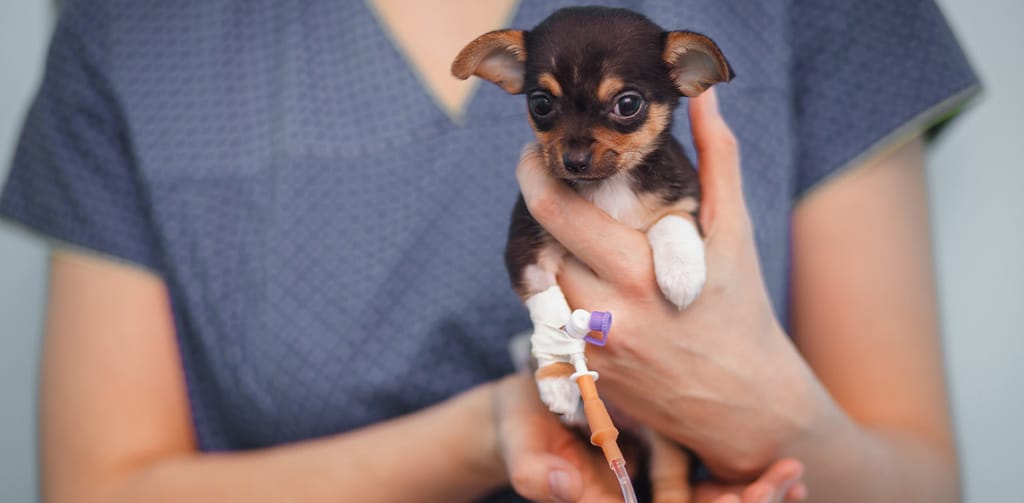Parvovirus is highly contagious and spreads quickly between unvaccinated dogs. Symptoms include severe vomiting and diarrhea, and sadly the disease is sometimes fatal despite treatment.
Severity:
Often severe
Table of Contents
Key points
- Parvovirus causes watery diarrhea which often contains blood
- A swab sample from your dog’s bottom or their stools can be tested for parvovirus, to confirm the diagnosis
- There is no specific treatment for parvovirus
- Parvovirus is very contagious to other dogs, and the virus particles are very hard to kill with cleaning chemicals
- The risk of parvovirus is minimal in vaccinated dogs
Common in
Any unvaccinated dog is at risk of parvovirus, so it’s especially common in young puppies.
Symptoms & types
Parvovirus is primarily a disease that targets the gut tissue. Therefore, if your dog has ‘parvo’, the most likely symptoms are vomiting, diarrhea, and lack of appetite. They will also be lethargic, have a fever, and may lose weight quite rapidly. Parvo can cause severe damage to the gut lining, so the diarrhea is often profuse and can contain blood and bits of dead tissue. The vomiting and diarrhea quickly lead to dehydration, not helped by nausea inhibiting appetite and thirst. Over a short space of time, dogs can become weak, and if the infection overcomes their immune system, they can develop septic shock. Sadly, around 40% of infected dogs will die from parvo even with treatment. Because treatment is intensive and expensive, many more dogs will be euthanized at diagnosis.
Parvo can cause severe damage to the gut lining, so the diarrhea is often profuse and can contain blood and bits of dead tissue.
Understanding the diagnostics
A veterinarian may have a suspicion that your dog is suffering from Parvovirus if they are unvaccinated and have typical symptoms. This is especially true if they are young puppies or their vomiting and diarrhea are particularly severe. Parvo is also said to have a distinctive smell, which is particularly unpleasant. A blood test to check your dog’s general health might show very low numbers of white blood cells as well as evidence of dehydration and general organ inflammation.
Nevertheless, no matter how conclusive the signs seem to be, Parvovirus needs to be confirmed or ruled out with a specific test. The test for Parvo is performed by taking a sample from your dog’s bottom with a cotton swab. This sample can then be tested for the virus, with the result usually taking less than half an hour.
Learning about the causes
Canine Parvovirus (CPV) is a virus belonging to the Parvovirus family. It is species-specific, meaning that only dogs can become infected with Canine Parvovirus. However, other types of parvovirus do exist and can affect other animals. CPV attacks the cells that line the intestine, causing them to die and shed. This leads to profuse, watery, and often bloody diarrhea. The diarrhea contains huge numbers of virus particles, as does any vomit that they produce. The virus particles are hard to kill, with only certain disinfectants being effective, and can persist in the environment for up to a year. Any contact with infected feces or vomit, as well as any contact with contaminated clothing, collars, harness, or bedding, can lead an uninfected animal to become infected. These factors combined make parvovirus incredibly contagious, spreading rapidly between unvaccinated dogs. In many dogs, it won’t be clear where they caught parvovirus from – it could be from a walk, from a puppy class, or whilst at the breeders.
Any contact with infected feces or vomit, as well as any contact with contaminated clothing, can lead an uninfected animal to become infected.
Best treatment options
Unfortunately, there is no treatment specifically for parvovirus. Therefore, it’s down to the dog’s immune system to fight it. What veterinary medicine can do, though, is support the dog while they fight the infection. This is done by giving fluid via a drip and treating any nausea and diarrhea symptoms.
Whilst antibiotics won’t help against a virus, they are sometimes given to treat any secondary bacterial infection that could take hold while the immune system struggles to fight the virus. Dogs infected with parvovirus tend to be hospitalized in an isolation kennel to avoid infecting other animals, and certain members of staff will be responsible for their care. After just a couple of days, it’s often clear whether the dog is making a recovery, although sudden deterioration is possible.
Home remedies & their effectiveness
Sadly, if your dog has parvovirus, the best place they can be is at a veterinary hospital. They will need expert care to keep them hydrated and ensure their body temperature remains under control. They will also need treatment to relieve their discomfort and ease their symptoms. So, if you’re tempted to try a home remedy or to try caring for your poorly pooch at home, think again. In very occasional situations, dogs that are recovering well at the veterinary clinic may be sent home to continue recovering, but they will still need regular veterinary visits and a pile of medications you cannot get without a prescription — home remedies are not effective against parvovirus.
There is no treatment specifically for parvovirus. Therefore, dogs infected with parvovirus tend to be hospitalized and get an expert vet care.
When to see a vet
If you have an unvaccinated dog or puppy with diarrhea or vomiting, it could be parvovirus. Of course, there are other conditions that cause some similar symptoms. Still, it’s important to find out if your dog has parvovirus as soon as possible so that supportive treatment can be started. Mild symptoms can be monitored if your dog is acting well in themselves, but dogs with parvovirus tend to go downhill quite quickly, going off their food and becoming quite lethargic. Therefore, if your dog’s symptoms aren’t clearing up, or if they are acting unwell, you should see a vet. The sooner your dog receives treatment, the more likely they are to recover, so it’s best to get veterinary advice right away. It’s also worth remembering that vaccinating your dog against parvovirus will help to keep them healthy and give you peace of mind.
FAQ
What are the first signs of Parvo in a dog?
The very first signs of parvovirus include a lack of interest in food, lethargy, and mild vomiting or diarrhea. However, symptoms can progress quite quickly, and within a few hours, diarrhea can become severe, smelly, and bloody. This leads to dehydration and weakness, and some cases can develop sepsis, so it’s worth getting your dog checked early on if they are unvaccinated and seem unwell.
Conclusion
Parvovirus is one of the most serious infections that a dog can get. Luckily, the availability of a vaccine has meant that it’s not as common as it used to be. Symptoms of parvovirus are severe and life-threatening, and any unvaccinated dog is at risk. If your dog isn’t up to date with their vaccinations, familiarize yourself with the signs of parvo and speak to your veterinarian about booking them in for a vaccination.
FAQ
With supportive treatment, including a fluid drip, antibiotics, and medication to improve the nausea and diarrhea, some dogs will recover from parvovirus, although survival rates vary. Sadly, even with treatment, the mortality rate of parvovirus can be as high as 30-80%.
If a dog has parvovirus, the virus will attack the cells lining their intestine. This causes the gut lining to shed, causing bloody diarrhea, weight loss, and dehydration. Dogs might also vomit, stop eating, and become weak. Infected dogs tend to develop a fever, and in extreme cases, can develop septic shock.
Although there has been some speculation about the long-term effects of parvovirus infection, most dogs who recover from parvovirus have no lasting health issues. However, they continue to shed the virus for up to a month after infection, so if you have other dogs, you should be very careful.

Dr. Hannah Godfrey MRCVS graduated from the Royal Veterinary College in 2011. Although she initially worked in mixed practice treating all species, she found a love for small animal work and has worked exclusively with dogs and cats since 2014. She lives in Wales with her partner, son, and two cats (named Poppy and Ashton Kutcher), and writes comedy fiction in her spare time.








